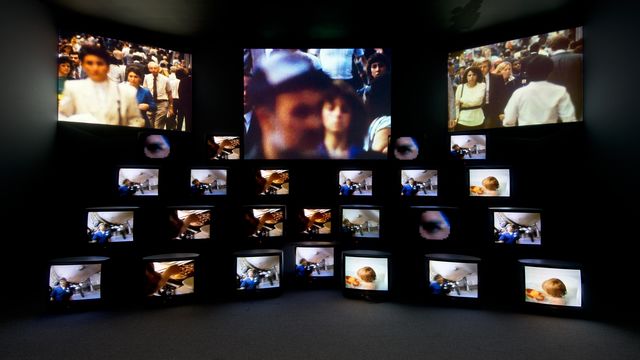
Gretchen Bender
Gretchen Bender arrived in New York in 1978 after spending five years as part of a feminist-Marxist screen-printing collective in Washington, DC. She initially employed appropriation tactics common to her circle of friends, which included Robert Longo, Richard Prince, and Cindy Sherman. For her early series of silk screens titled The Pleasure Is Back (1982), Bender reproduced on tin images from the work of successful male artists such as Sandro Chia, Roy Lichtenstein, and A. R. Penck, reducing them to their most iconic forms to generate art "logos." This interest in critically appropriating powerful carriers of meanings led Bender to television, and she became a pivotal force in expanding the concerns and strategies of the "Pictures" artists to this medium.#
In an interview with Cindy Sherman, Bender described mass media as a "cannibalistic river" that absorbs everything in its path and flattens out all content. Seeking to imitate and infiltrate the late-capitalist media landscape, Bender told Sherman, "I'll mimic media, but I'll turn up the voltage on the currents so high that hopefully it will blast criticality out there."# Bender's installations of television monitors and collages of footage from various genres within the medium, including disturbingly violent news images, repurpose America's favorite media machine to advance a critical mode of spectatorship. In many works, multiple screens disrupt the singular viewpoint of the living-room television set. Bender also adhered phrases such as "revolution" and "living with AIDS" directly onto TV screens so that they were superimposed on broadcast footage in order to expose television's naturalizations of the status quo and eradication of difference. Her installations invite viewers to re-view television, to detect the systems that dictate the media environment.
In the eight-channel video installation Total Recall (1987), twenty-four synched television monitors and three rear-projection screens generate a kaleidoscopic wall of images that stutter, swipe, and merge. In one segment, the computer-generated corporate logos of CBS and NBC dance across the screens before disappearing into churning gray clouds and bursting abstract patterns that give way to incongruous fragments rapidly edited together: commercials for consumer electronics; clips from Hollywood films such as Under Fire (1983) and Salvador (1986); and images of shiny cars, sweating runners, and suburban families. The onslaught of images—carried along by a droning, percussive soundscape composed by Stuart Argabright (of the electronic band Ike Yard)—gestures to deep structural patterns and ideologies that govern the image stream. Total Recall is a kind of electronic theater that, according to Bender, examines "what it is we're really promoting to ourselves—the cultural lies, the cultural anxieties, the cultural truths."# The gripping eighteen-minute audiovisual event gives the impression of a highly coordinated, techno-military image industry.
Bender coined the term sense-around to describe the heightened responsiveness that she aimed to engender through her media installations. She recognized their fleeting critical function, however, joking that it took ten minutes for her works to be "neutralized."# Like many of her peers in the 1980s, Bender was concerned with what David Robbins called "the vast synthetic world established by the camera," but rather than extract and distill, her artistic practice multiplied and amplified.# The criticality (and self-aware critical ambivalence) of her immersive forms and accumulative approach anticipates the discourses and practices of more recent technological art.
—Ruth Erickson


